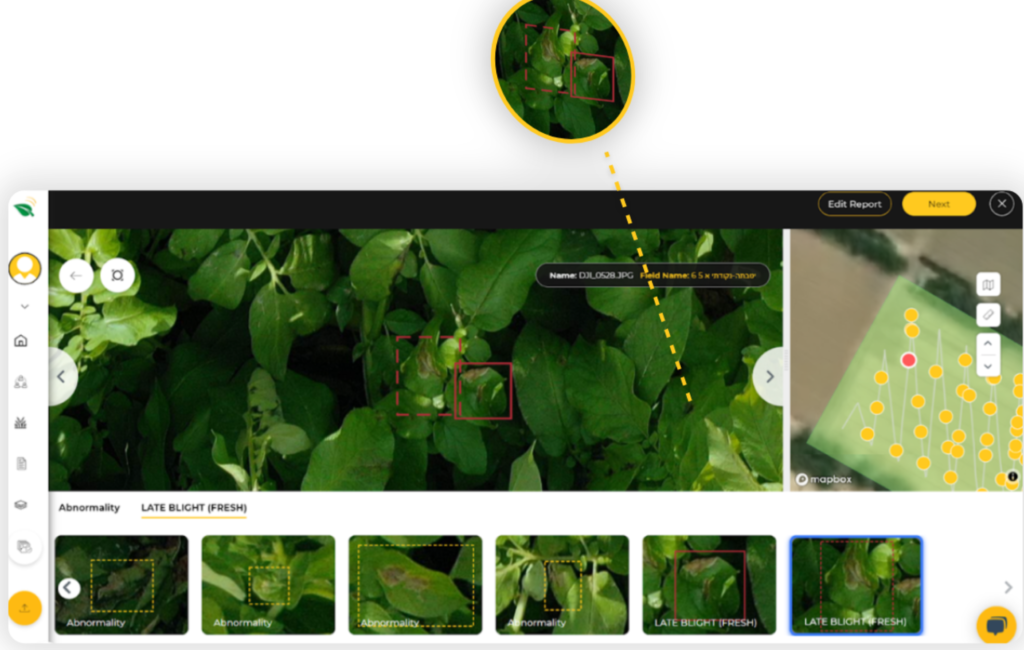Efficient Potato Disease Management Using DJI Multispectral Drones

Your favourite potato chips are actually related to drones. Let’s take a look at what kind of technological care it needs to grow.
Speaking of crispy potato chips, everyone has eaten them, but you may not know what kind of technological care a potato needs to undergo during its growth process before it grows into a potato and then sliced into chips.
“For agronomists, taking care of potatoes is like taking care of children” – the drone specialists at DJI Agriculture.
They will need to pay attention to its growth and pests at any time, and apply fertilizers and pesticides according to the farming season. Once there is a problem, a year of hard work will be in vain.
Since 2020, DJI Agriculture has begun to provide a digital agriculture solution for a world-renowned food company. It provides a complete set of solutions for terrain monitoring – growth monitoring – pest monitoring – variable fertilization and pesticides through drones to provide refined and digitalized potato planting. management to increase production and income. So far, the Phantom 4 multispectral drone has been applied to its 14 farms, using an area of more than 10,000 Acres.
(Note: The latest multispectral drone model released by DJI at the end of 2022 is the Mavic 3 multispectral)
Terrain monitoring
Land leveling is very important for potato growth. Uneven drip irrigation plots can easily cause uneven distribution of water and fertilizer, and the growth of plots varies greatly. At the same time, depressions are prone to the accumulation of water, resulting in a high incidence of pests and diseases.
In August 2022, at the Hebei farm of Lay’s Farm, agronomists used the Phantom 4 multi-spectral drone to monitor the elevation of the fields and then reconstructed the aerial imagery through the DJI smart agriculture platform to identify the highlands and depressions of the plot.
The blue part is low-lying fields
Based on the elevation map, agronomists can focus on and inspect depressions during periods of high disease and insect pest incidence to improve management efficiency. In addition, when laying the drip irrigation belt, it can also be designed according to the elevation map to make up for the spatial difference of water and fertilizer caused by the height of the terrain.
Growth monitoring
In the past, the farmland of 100 Acre required an agronomist to walk a day to complete it, and it could not completely cover every corner. Multi-spectral drones can complete field inspections in a few hours so that the whole field can be seen at a glance, and the growth of the whole field can be viewed through vegetation indices such as NDVI.
In 2022, Lay’s Farm used the Phantom 4 multi-spectral drone to monitor the farmland, capture the difference in the growth of potato plants, and make timely adjustments to farmland management.
Pest monitoring
In the past, agronomists needed to inspect the growth of potatoes on foot, but due to the limitation of walking speed and field of vision, it was easy to miss early disease sites. The use of drones can achieve efficient and full coverage of the field, greatly improving management efficiency and quality. Based on high-definition images captured by drones, combined with
AgroScout’s artificial intelligence automatic identification can also efficiently monitor potatoes for early blight, late blight, nutrient deficiencies, insect pests, and other abnormalities.
Variable Fertilization
Traditional crop protection operations are generally applied throughout the field and cannot be targeted with the areas. There is the problem of excessive use of pesticides and fertilizers, resulting in waste of input and environmental pollution.
In July 2022, Lay’s Farm used the Phantom 4 multispectral drone to monitor potatoes, accurately judged the difference in potato field growth based on NDVI vegetation index, and generated a variable fertilization prescription map to guide the T40 drone variable spraying of foliar fertilizer. The dosage of 24L/Acre is used for areas with weak growth, and the dosage of 12L/Acre is used for areas with better growth. While reducing the amount of fertilizer, uniformity of growth is ensured.
In addition, traditional ground rig spraying needs to reserve lanes for tractors, which will occupy about 1/7 of the farmland area. The use of drones for full flight control can avoid production losses caused by reserved aisles, which is equivalent to avoiding a 5% production reduction.
- Tractor tracks
In addition, local agronomists said that in the case of a lot of rain, large tractors could not go to the field, which would have a greater impact on agronomic operations.
Moreover, in the later stage of potato planting, the tractor entering the field easily scratches the potato seedlings, increasing the risk of disease occurrence and spread. Drone operation does not touch soil and plants, reducing plant damage.
Lay’s, a global food and beverage industry leader, is committed to building a sustainable food system and promoting sustainable agriculture. By providing reliable digital agricultural solutions and intelligent equipment, DJI helps to achieve refined management of potato cultivation and promotes the green and high-quality development of the potato industry.
In the future, DJI Agriculture will continue to innovate, using advanced technology and solutions to empower more partners with field management, help improve the quality and efficiency of agricultural production, make agriculture easier, and make life better.
Articles translated by the team of Wonderfull Inc.
Copyright belongs to DJI Agriculture.
Text : 647 287 6851